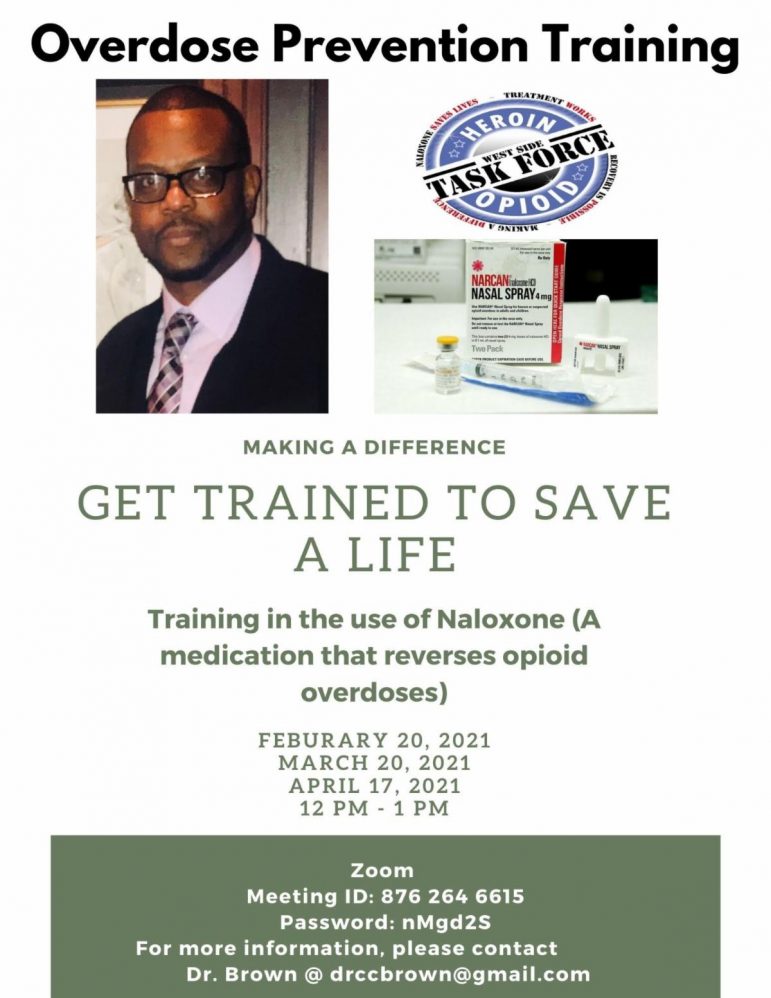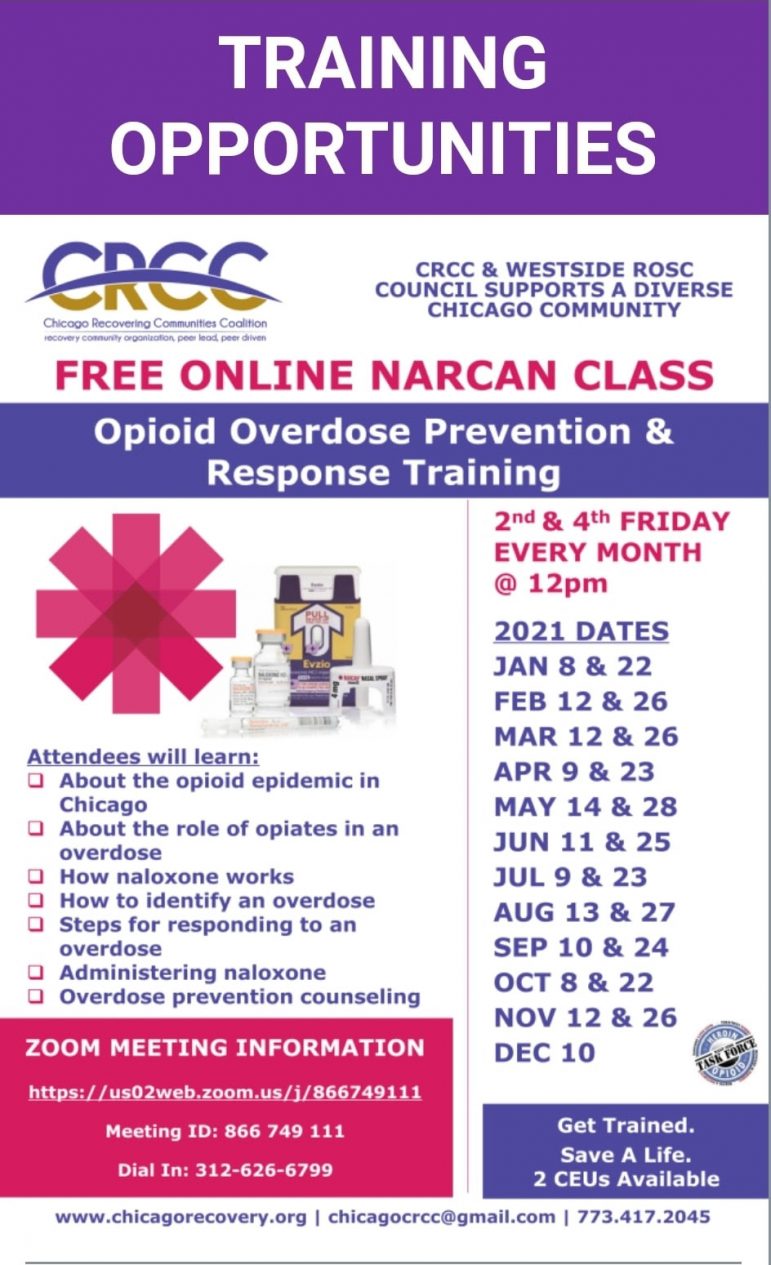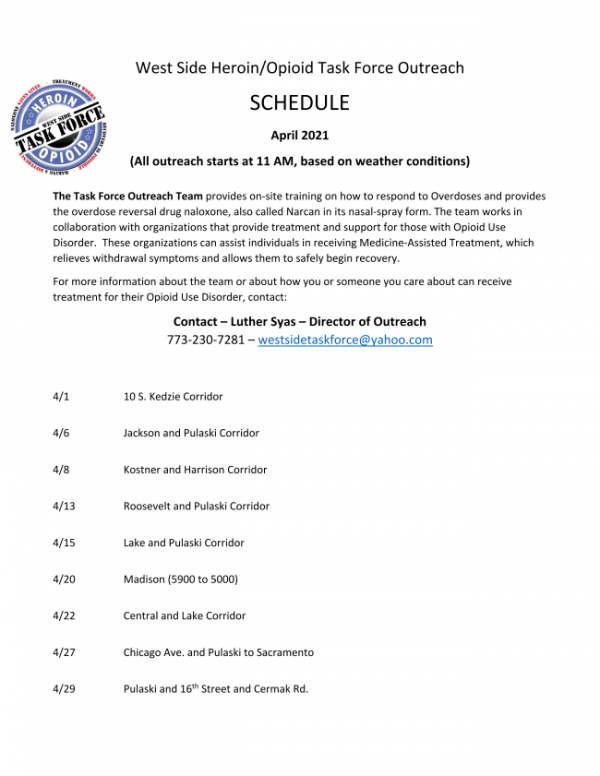Two or three times a week, Luther Syas and his team set up a couple folding tables on a West Side street corner.
The tables are stocked with injectable naloxone kits and boxes of Narcan spray, and information about how the opioid reversal drugs work and treatment programs.
It’s all part of the West Side Heroin and Opioid Task Force’s mission to reduce overdose deaths on the West Side.
Rep. La Shawn Ford said he started the task force because he’s seen friends and family members struggle with opioid use, and “the drug problem is one of the biggest problems impacting the quality of life on the West Side.”
The Austin lawmaker said the task force has built “a strong coalition of people to fight this epidemic.”
And it is an epidemic. The U.S. Centers for Disease Control and Prevention recently reported that 2020 was the nation’s deadliest year ever for drug overdoses, with a record 81,000 people overdosing during the lockdown.
In Cook County, opioid overdose deaths last year surpassed 2019’s record-breaking tally, with 1,498 cases confirmed as of early December, the Chicago Tribune reported.
At regular outreach events on the Wes Side, those struggling with opioid use who’ve decided “I want to get out of this” can connect with treatment through Thresholds, Syas said.
“Most people are receptive and want services,” said Lynn Boswell, a recovery coach. But they’re often leery of treatment programs, many of which require in-patient care.
“Once they find out that it’s not an in-patient, that it’s out-patient, they’re really excited about that,” she said.
Boswell said the goal is to set people up for success.
Thresholds not only offers medication-assisted-treatment and counseling, but it also can link those in treatment with services to get their Social Security card, birth certificate and state ID, and help in finding employment, she said.
Syas said another aspect of their outreach is having people in the field who’ve lived through opioid use disorder. It’s important, he said, because they know firsthand what users are going through and understand how to connect with them.
Gail Richardson has that firsthand knowledge. She used to use heroin but has been clean for 18 years, she said.
She joined the task force, because, “if I could just tell one person how I got clean, maybe they want to be clean, too,” she said.
Richardson sees the outreach as a matter of life and death.
Even for people who don’t use, “we’re sure you know somebody that use. Even if it’s a family member or a friend or if you’re walking up the street, you can save someone’s life,” she said.
Dr. Thomas Huggett, of Lawndale Christian Health Center, said the frequency and amount of naloxone being administered in the field is going up. While it used to be the norm for one dose to be administered, “the EMTs are telling us they have to give three, four or five,” he said.
Illinois Department of Public Health data shows opioid overdose deaths in urban counties increased 55% in 2020.
Dr. Huggett said the uptick in overdoses and overdose deaths is partially due to the increased prevalence of fentanyl, which is 50 times more powerful than heroin. Some users are, unbeknownst to them, being given straight fentanyl.
He said patients will come in thinking they’ve done heroin, “but actually, when we do the urine test, there’s no heroin in the urine. But I test for fentanyl, and there’s fentanyl.”
Syas, who’s lived on the West Side since the late 1960s, said before fentanyl became common there weren’t as many deaths. “This stuff is real mean.”
Chicago Department of Public Health data shows in 2019, 80% of overdose deaths involved fentanyl.
Richardson said some people are concerned about carrying the, potentially life-saving naloxone because they think the police will arrest them for it. “We had to explain to them that it’s a law, you can carry it,” she said.
Richardson said the first time she administered naloxone it was scary. “I mean, I was shaking, but it brought him back.” She said in the moment, “I did what I knew I was supposed to do.”
When teaching people how to respond to an overdose, she tells them, “first thing is just relax. Just know you’re going to do the best you can … to save their life, just relax,” she said.
She said it will be nerve wracking if you have to use naloxone on someone, but, whatever happens, “you know you’ve done all you can do. You gave it your all.”
The task force “is making a difference. It is helping a lot of people and I am so grateful,” Richardson said.
The people the West Side Heroin and Opioid Task Force trains, “they’re literally lifesavers,” Rep. Ford said.
“It’s a simple dose that actually saves the life. Just like we want every household to have smoke detectors and carbon monoxide detectors, we believe that every household should also have a Narcan kit,” he said.
The West Side Heroin and Opioid Task Force hosts training for the use of naloxone and Narcan each month.


